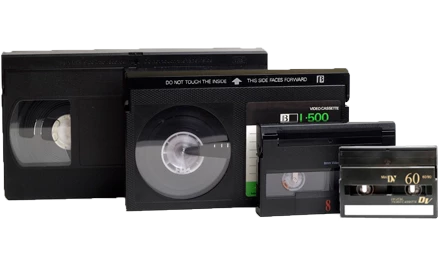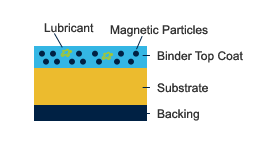
If you’re hanging onto old video tapes because they bring back memories of the good old days, keep in mind magnetic memories have a strong tendency to slip away. That begs the question, how long does magnetic tape last? The components that enable VHS and other magnetic video tapes to play are impermanent and the primary reason why they’re prone to VHS damage. But to fully understand why video tapes are fragile, it helps to know the basics about their components.

VHS, SVHS, VHS-C, and Hi8 video tapes are composed of three layers: the binder layer, the substrate, and the backing. While slight differences exist from manufacturer to manufacturer, the engineering of these layers is intended to help video tapes survive the friction and stress of repeated playback, winding, and rewinding.
The binder layer comes into direct contact with the heads of the playback machine and is responsible for signal quality. It contains magnetic particles (usually made of iron oxide) that store information on the tape. The particles are typically suspended in the binder along with lubricant, which prevents damage to the binder caused by the drum and head of the playback deck. The substrate and backing layers add dimensional stability and strength because the binder layer itself is quite thin. The backing layer also helps to reduce friction.
VHS tape life expectancy varies from one VHS tape to the next. In general, VHS deterioration of 10–20% occurs over a period of 10 to 25 years. Better quality tapes have a slightly longer lifespan, as do VHS tapes that have been kept in a climate-controlled setting. If you still own a collection of videos from the 1990s, it’s inevitable that some of the footage has already suffered the ravages of time. While minor issues may be repairable, the sooner you convert magnetic memories to digital, the better your chance of reliving the good old days.
Temperature swings can stress the substrate and backing. In addition to causing tracking problems, improper storage can result in serious VHS problems like mold. While proper storage can help prevent or postpone some issues, magnetic tape is inherently unstable and no tapes are immune from these issues. Nevertheless, following these tips can help maximize life expectancy and quality until you get your video tapes digitized.
Some degree of VHS deterioration is inevitable, despite your best efforts to extend the lifespan of your favorite movies. If you want to preserve video tapes for posterity, your best option is to convert them to a forever digital format. When you choose ScanCafe to digitize old VHS tapes, we do our best to ensure the viewing quality is better than the original!
The best way to preserve VHS tapes is to convert them to a digital format. While proper storage can help delay deterioration, magnetic tape is inherently unstable and prone to issues like color shifts, loss of detail, and tracking errors. By digitizing the tapes, you can ensure their long-term preservation and prevent further decay. ScanCafe, as a film digitizing company, specializes in converting VHS tapes to a forever digital format, providing better viewing quality than the original tapes.
Storing VHS tapes in plastic containers is not recommended. Improper storage can result in serious VHS problems like mold and tracking errors. It is best to store tapes in a cool and dry place with little to no climate change, in the recommended temperature and humidity levels. Tapes should not be stored in basements, attics, or on the floor, and should be kept away from water pipes and magnetic sources. However, even with proper storage, magnetic tape is still prone to deterioration, which can only be prevented by digitizing the tapes.